1. Assi Ghat
Distance from BHU – 2.1 KM
Assi Ghat is the southernmost ghat in Varanasi. To most visitors to Varanasi, it is known for being a place where long-term foreign students, researchers, and tourists live. With hosting Subah-e-Banaras in the morning, assi ghat provides a spectacular notion of river Ganga.
Tourism at Assi GhatAssi Ghat is the southernmost ghat in Varanasi. It is one of the biggest ghats of Varanasi and most popular one. To most visitors to Varanasi, it is known for being a place where long-term foreign students, researchers, and tourists live. Assi Ghat is one of the ghats often visited for recreation and during festivals. On typical days about 300 people visit every hour in the mornings, and on festival days 2500 people arrive per hour. Most of the people visiting the ghat on usual days are students from the nearby Banaras Hindu University. The ghat accommodates about 22,500 people at once during festivals like Shivratri. During iconic Dev Deepawali festival, more than 600,000 tourists visit the ghat. There are a lot of activities for tourists to engage in at the ghat. Visitors can go for boat rides, go up in a hot-air balloon for an aerial view of Assi ghat, enjoy the daily talent show in the evening or eat at one of the many restaurants and cafes in the area.
Hindus believe that it was at Assi Ghat that Tulsidas left for his heavenly abode.
After the 2010 Varanasi bombing the city commissioned extra police to the Assi Ghat neighborhood in order to more quickly resolve problems which tourists might have.
Subah-e-BanarasSubah-e-Banaras, an early morning session before dawn (sunrise) started on 2014 by Minister of State, Uttar Pradesh Government. A committee has been constituted to glorify and propagate the celestial moments of Subah-e-Banaras for spiritual development. People from all walks of life joined hands together to perpetuate the early hour’s effort to feel within existence of Almighty and grandeur of Nature. It is daily session which last for 2 hours and is free of cost.
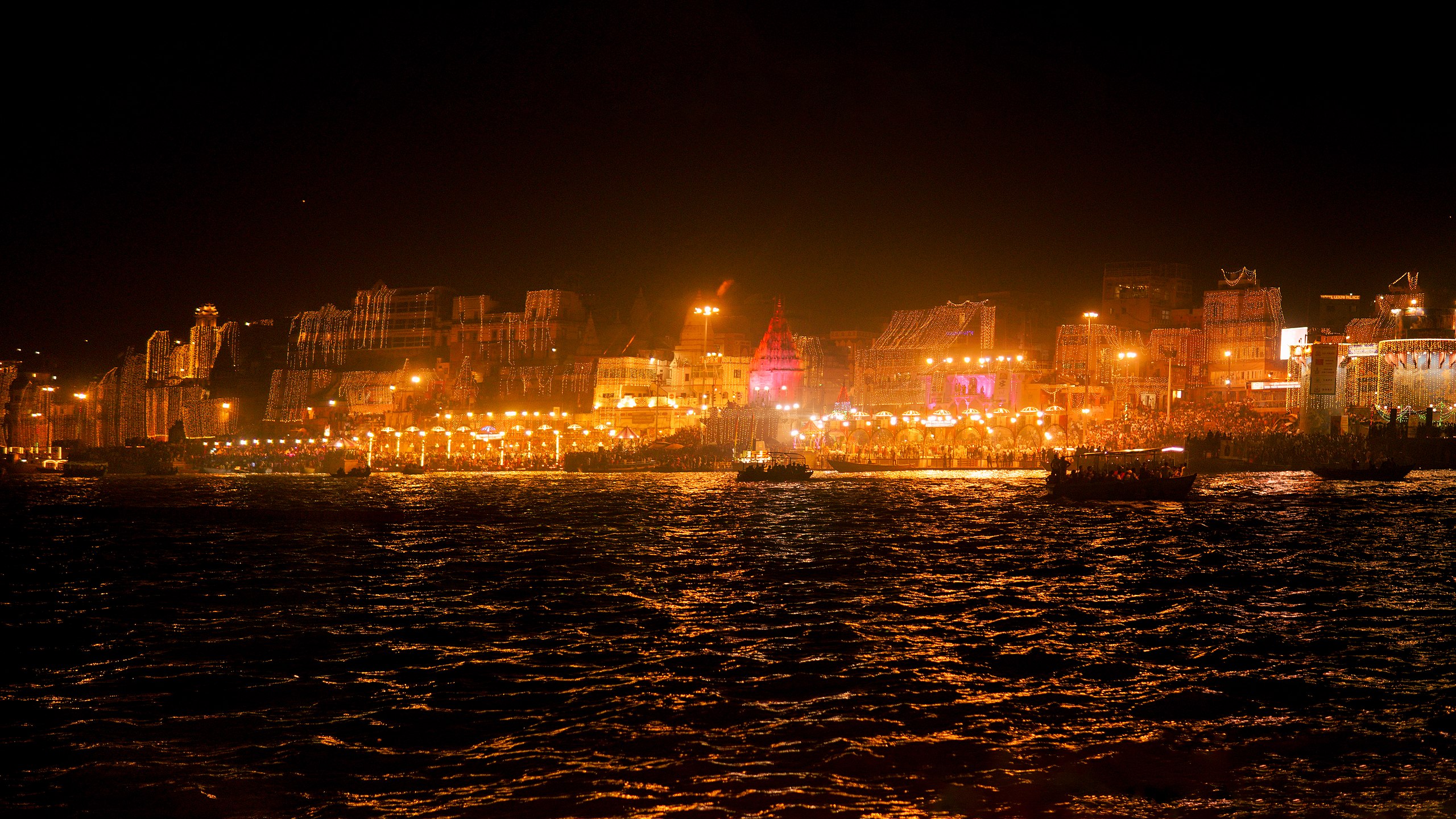
Assi Ghat During Dev Dipawali


Drone Shot of Assi Ghat
2. Dashashwamedh Ghat
Distance from BHU – 4.9 KM
Dashashwamedh Ghat is a main ghat in Varanasi located on the Ganges River in Uttar Pradesh. It is located close to Vishwanath Temple. There are two Hindu legends associated with the ghat: according to one, Brahma created it to welcome Shiva, and in another, Brahma Performed 10 Ashwamegha Yajna, Dasa-Ashwamedha yajna.
The present ghat was built by Peshwa Balaji Baji Rao in the year 1748. A few decades later, Ahilyabahi Holkar, the Queen of Indore, rebuilt the ghat in the year 1774.
Ganga aartiThe Ganga Aarti (ritual of offering prayer to the Ganges river) is held daily at dusk. Several priests perform this ritual by carrying deepam and moving it up and down in a rhythmic tune of bhajans. Special aartis are held on Tuesdays and on religious festivals.
The Ganga Aarti starts soon after sunset and lasts for about 45 minutes. In the summer, the Aarti begins at about 7pm due to late sunsets and in winter it starts at around 6pm. Hundreds of people gather at the ghat every evening to watch the event.

3. Kashi Vishwanath Temple
Distance from BHU – 5.1 KM
The Kashi Vishwanath Temple is a famous Hindu temple dedicated to Shiva. It is located in Vishwanath Gali, near Varanasi, Uttar Pradesh, India. The temple is one of the most sacred Hindu pilgrimage sites and is among the twelve Jyotirlinga, shrines which are said to be the most sacred abodes of Shiva. Standing on the western banks of the Ganges, the presiding deity is known by the names Shri Vishwanath and Vishweshwara.
Varanasi was called Kashi (“shining”) in ancient times, and hence the temple is popularly called Kashi Vishwanath Temple. The temple is considered a central part of worship in Shaiva culture by Hindu scriptures.
The temple had been demolished several times, most recently by Mughal emperor Aurangzeb, who constructed the Gyanvapi Mosque on its site. The current structure was built on an adjacent site by the Maratha ruler Ahilyabai Holkar of Indore in 1780.
Since 1983, the temple has been managed by a board of trustees set up by the government of Uttar Pradesh.

4. Sarnath
Distance from BHU – 13.6 KM
Sarnath is a significant destination for tourists and pilgrims in India, particularly for those interested in Buddhism and its history. Located near the city of Varanasi in the northern Indian state of Uttar Pradesh, Sarnath holds immense historical and religious importance. Here are some key aspects of Sarnath tourism:
Buddhist Pilgrimage: Sarnath is one of the four most important Buddhist pilgrimage sites in India, along with Bodh Gaya, Lumbini, and Kushinagar. It is the place where Lord Buddha is believed to have given his first sermon after attaining enlightenment, known as the “Dhammacakkappavattana Sutta” or the “Turning of the Wheel of Dharma.”
Dhamek Stupa: The Dhamek Stupa is a prominent structure in Sarnath and is said to mark the spot where Buddha gave his first sermon. It’s a massive stupa with intricate carvings and a serene atmosphere. Tourists and pilgrims often circumambulate it.
Chaukhandi Stupa: This stupa is believed to be the spot where Lord Buddha met his first five disciples after attaining enlightenment. It offers a beautiful view of the surrounding area.
Sarnath Archaeological Museum: The museum in Sarnath houses an impressive collection of Buddhist artifacts, sculptures, and relics. It’s an essential stop for those interested in the history of Buddhism.
Mulagandha Kuti Vihar: This modern Buddhist temple is known for its beautiful frescoes depicting the life of Buddha. It’s a peaceful place for meditation and reflection.
Japanese Temple: Also known as the Nichigai Suzan Horin-ji Temple, it’s a striking temple built in a traditional Japanese style. The lush gardens and serene ambiance make it a popular attraction.
Thai Temple: The Wat Thai Sarnath is a Buddhist temple built in Thai architectural style. It’s known for its golden spires and serene atmosphere.
Ashoka Pillar: The Ashoka Pillar is an important historical artifact in Sarnath. It features four lions back to back, which is now the national emblem of India. The original pillar is housed in the Sarnath Museum, while a replica stands at the site.
Sarnath Excavated Ruins: You can explore the ancient ruins of monasteries, stupas, and temples in the archaeological site of Sarnath, giving you a glimpse into its rich history.
Sarnath is easily accessible from Varanasi, which is well-connected by air, train, and road. It’s best to visit during the cooler months from October to March to enjoy your trip to the fullest. Whether you are a Buddhist pilgrim or a traveler interested in history and spirituality, Sarnath offers a unique and enlightening experience.
5. Deendayal Hastkala Sankul
Distance from BHU – 14.9 KM
Deendayal Hastkala Sankul – A Trade Centre and Museum
In 2014, Prime Minister Narendra Modi laid the foundation stone of an ingenious institution – Deendayal Hastkala Sankul at Badalalpur, Varanasi. The state-of-the-art institution is a careful amalgamation of a trade center and a museum, ideated by the Ministry of Textiles, to support the handloom and handicraft sectors of the region. This initiative aims towards providing a dais for the enhancement of trade, offering impetus to domestic and international buyers, and exhibiting and preserving the handloom and handicraft heritage of Varanasi and the regions around it.
One of the oldest living cities, Varanasi is a treasure trove of art, culture, traditions, and heritage. Known for its mesmerizing ghats and temples, the city offers a multitude of diversity when it comes to handicrafts. Banarasi sarees, brassware, ivory carvings, wooden crafts, and much more attractive people from all over the world visit this city. Owing to this recognition, the Deendayal Hastkala Sankul has been set up here to offer a stage for these local artisans and craftsmen to practice. The facility has its own fully equipped workshop area for the artisans to work and interact with each other and develop a wide network in the community.
The in-house museum of this center has an enthralling display of crafts and textiles that showcase the rich tradition of Varanasi by engaging its visitors. The museum also preserves the rare and finest examples of Varanasi crafts as a reference source for the development of Indian crafts. Divided into four galleries – TanaBana and Handloom Gallery, Carpet Gallery, Handicraft Gallery, and Art Gallery, the museum has aesthetically curated exhibitions to amplify the artifacts.
- TanaBana and Handloom Gallery: The major collection of the museum is dedicated to textile and handlooms. This gallery has on display 41 varieties of weaving methods in handlooms.
- Carpet Gallery: The display in this gallery is dedicated to the intricate art of carpet making and to the artisans. The gallery is designed in such a manner that it encompasses topics such as the history of carpets in India, making techniques, source of raw materials, and so on. It is a one-stop destination for artists, tourists, and textile enthusiasts who wish to know more about carpet weaving and its history.
- Handicraft Gallery: The gallery is on the first floor of the building along with the handloom and carpet gallery. The display here is mesmerizing for the visitors with 425 artifacts(ivory carvings, wooden objects, brassware) on display showcasing the rich handicrafts of the region.
- Art Gallery: The art gallery of the museum has a beautifully curated display of paintings and artworks. The spacious environment allows the visitors to observe and appreciate the collections.



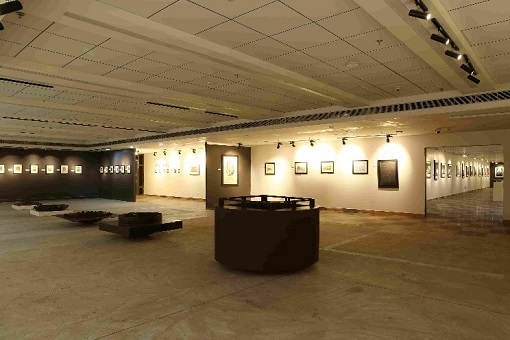
After inaugurating it on 22nd December 2016, the Prime Minister, on 22nd September 2017, visited it and dedicated this facility to the nation with a vision to encourage people to visit the center and further amplify tourism in the region. He emphasized on the positive impact that Deendayal Hastkala Sankul would have on the lives of the artisans and weavers and further inspire future generations to carry on the legacy. On 22nd January 2019, the Prime Minister inaugurated 55 outlets as Centers of Excellence within the complex. This initiative is a milestone achievement towards the development of Indian handicrafts and handlooms and a necessary step towards reviving the art and cultural heritage of India.
6. Nammo Ghat
Distance from BHU – 11.9 KM
Varanasi, the city full of dazzling charm doesn’t need any introduction. This place is the best if you value calmness and inner peace. Everyone has heard about the heaven but if you want to experience it on the Earth then you must visit Varanasi. You can take part in a variety of religious rituals and feel the presence of gods here. Tourists come there from all over the world for various such reasons. Not only to live in Varanasi, Hindus believe that if they die in this holy city, they would be released from the endless cycle of reincarnation. Apart from religious significance, Varanasi has much more to explore. One of the major tourist attractions in this holy city is the newly reconstructed “Namo Ghat”. Let us explore this beautiful place in detail.
The Mystical Beauty of Varanasi: Namo Ghat
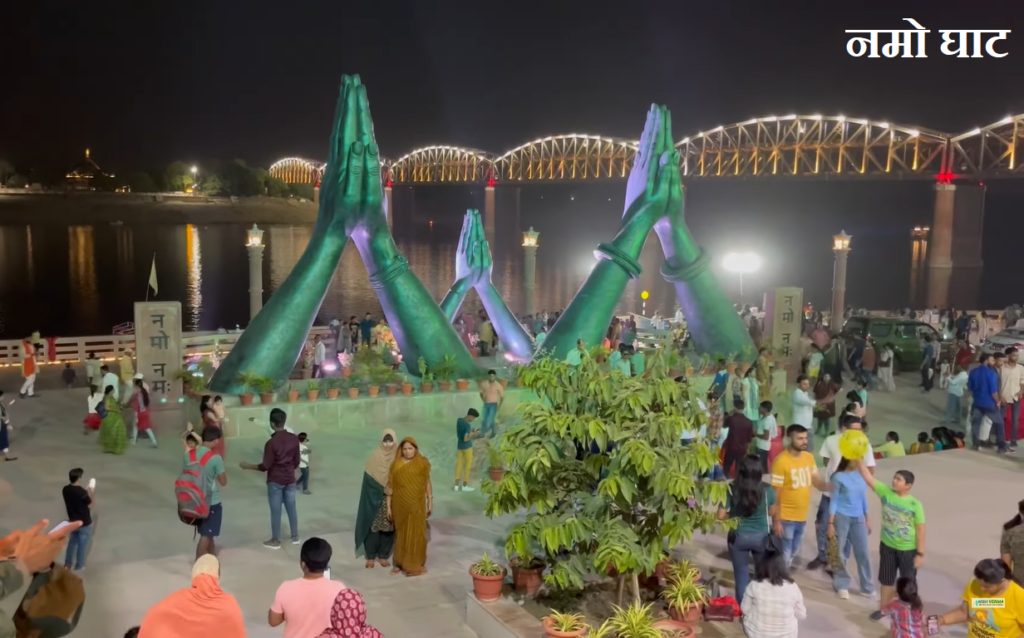
There are 84 ghats in this holy city. Thousands of people flock to the ghats of the Ganges every day in Varanasi. The ‘Khidkiya ghat,’ is reconstructed and came to be known as ‘Namo Ghat’. The Namo Ghat in Varanasi is now the 85th ghat in the city.
One of the most striking elements of this ghat is a magnificent hand folded sculpture. Because of three massive sculptures in the shape of hands folded in ‘namaste,’ it has become a popular tourist attraction. Namo is an expression of our culture in which we welcome visitors by joining our palms and saying “Namaste.” The sculptures of folded hands became the new identity of the ghat. They appear to welcome our visitors to the land of Kashi.
Namo Ghat is Kashi’s first Ghat to be accessible by water, land, and air. The city has what seems to be the new Kashi look, which is something that attracts many visitors. Its minimal interior design and traditional Kashi wall paintings throw off an air of both modernity and heritage. Visitors to Varanasi will see a visual representation of our culture and respect for them here.
A Journey into Varanasi’s Sacred Namo Ghat
Its name, NaMo, which also means Namaste mudra, is said to be taken from the name of our beloved Prime Minister NArendra MOdi.
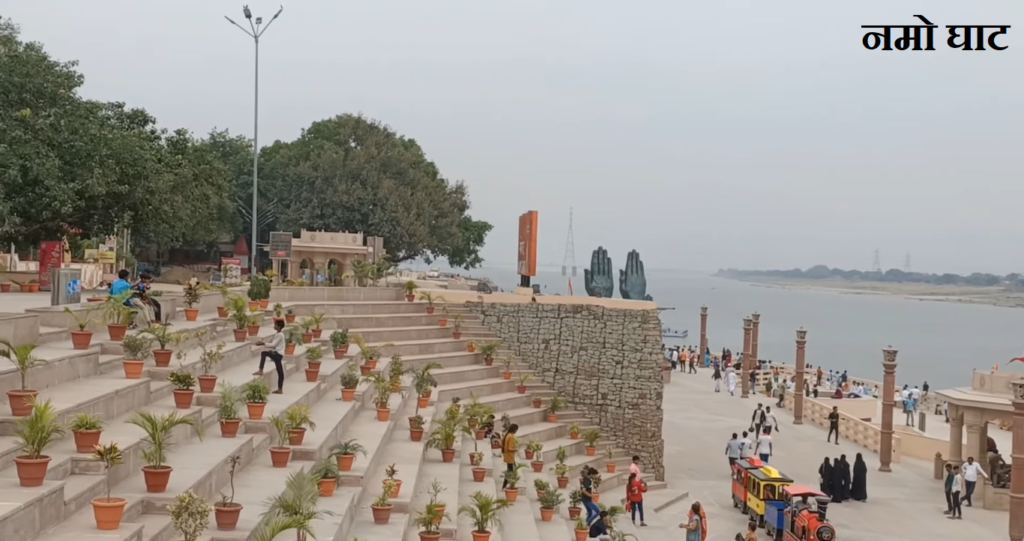
This ghat has had many improvements made to it, including a plaza with souvenir and local artwork shops, CNG filling stations for vehicles on the ground level and Boats on the river bank, a jetty for boarding and releasing boats, and instructions and lighting. Here, students would have space for strolling, exercising, and yoga, as well as access to water adventure activities. Additionally, there will be an open theater, a library, a food court featuring Banarasi cuisine, and a versatile platform that may be utilized as a helipad or to organize other events. For the benefit of the elderly and those with disabilities, a ramp has been constructed all the way to the river. Divyangjan can walk or roll his wheelchair onto this ghat from the road, putting them right next to Maa Ganga. It is unique in the way that no other ghats give equal attention to people with disabilities.
To clean up the Ganga, a floating CNG station has been constructed by GAIL India near the ghat for CNG boats. Additionally, it would be possible to take a ship to see other surrounding cities. A half kilometer long, Namo Ghat features advertisements for Make in India and Vocal for Local. There is a cafe, platforms, and murals on the walls that display Kashi’s cultural past. Tickets for “Sugam Darshan” at Kashi Vishwanath Dham would also be available here, and pilgrims would have the option of traveling by boat from the jetty to Kashi Vishwanath Dham. This location now features parking spots, a playground, and an area for clicking pictures.
The Making of Namo Ghat
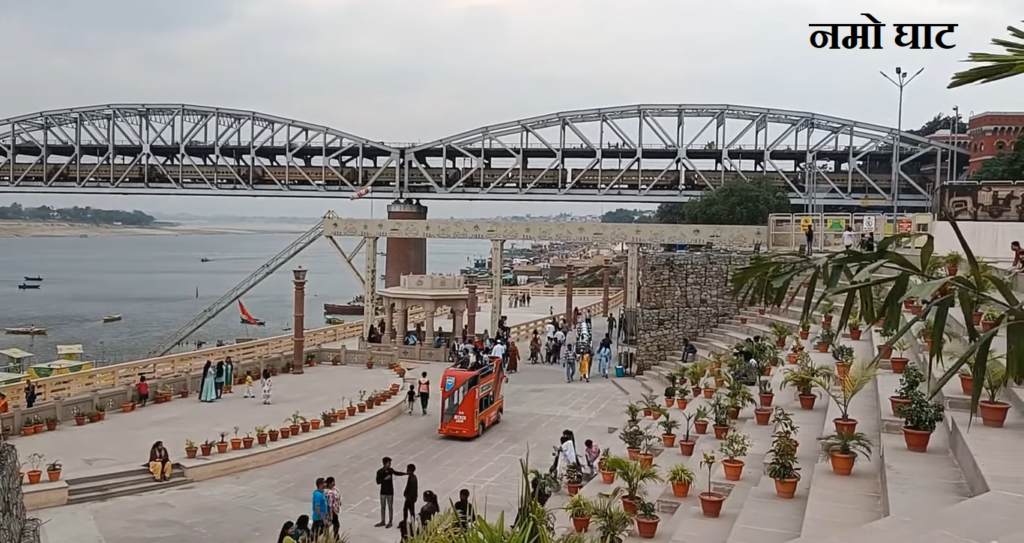
The restoration of the Khidkiya ghat was officially began in 2019 with the laying of a foundation stone by Prime Minister Narendra Modi. The ghat was renamed “Namaste” after sculptures of folded hands were built. This ghat, which covers an area of roughly 21,000 square meters, racked up a price tag of Rs. 34 crores.
D Vasudevan, chief general manager of Varanasi Smart City Limited, said that once construction on phases II and III is finished, Namo Ghat will become the longest ghat along the Ganga in Varanasi, spanning 1.71 km from Bhaisasur Ghat (Rajghat) to Aadi Keshav Ghat at the confluence of the Ganga and the Varuna.
Prime Minister Narendra Modi was scheduled to open the Namo Ghat in July 2022, once phase-I construction was finished, and the statues of three ‘namaste’ (pair of joined hands) were placed there as a welcoming gesture. However, plans were altered, and it was determined that the official opening would take place once the final phase of construction was finished. The Namo Ghat project’s second and last phase will be finished by June, and it will be formally inaugurated at that time.
Best Time to Encounter the Stunning Scenery of Namo Ghat
The afternoons and evenings in Varanasi are the most popular times to visit. Namo Ghat is at its most beautiful in the early or late hours of the day. Mornings and evenings are the best times to visit Namo Ghat because that’s when the region is at its busiest and the light is at its greatest for photography. If you want to feel the ghat’s revitalizing energy, you should come early in the day. There’s plenty of room to park, and the entrance is well-marked and secured. Witnessing the beauty of holy river Ganga in the evening will be much delight to the eyes. However, the sightseeing on boat will be like the icing on the cake.
If looking about season, Namo Ghat is at its most beautiful during the winter months of November through February. In Varanasi, the temperatures range from about 5 degrees Celsius to about 25 degrees Celsius throughout this season, making it perfect for outdoor activities and tourism.
How to Reach Namo Ghat
Namo Ghat is situated near Rajghat Varanasi, Uttar Pradesh. It is easily accessible through different modes of transportation. People in Varanasi or from outside cities can easily manage to reach there.
By Roadways: Varanasi has excellent road connections to other regional hubs. Namo Ghat is easily accessible from everywhere in Varanasi via cab, auto, e-rickshaw, or cycle-rickshaw. The Varanasi Cantt bus station is located around 6 kilometers from Namo Ghat.
By Railways: The Varanasi Junction railway station is the main city station that connects the city to other important Indian cities. The distance from the Varanasi station to the Namo Ghat is about 6 to 7 kilometers. Outside the station, you can find auto rickshaws and taxis. Passengers can also use a private cab service to reach the destination spot.
By Airways: Lal Bahadur Shastri International Airport is the closest airport to Varanasi. To get to Namo Ghat from the airport, you can either rent a cab or take a pre-paid taxi. By road, the distance between Varanasi Airport and Namo Ghat is 25 km via NH31. It takes approximately 55 minutes to reach Namo Ghat.
If you are a travel enthusiastic, Varanasi should be in your travel list. The perfect blend of modernity and heritage will give you a unique and unforgettable experience. Happy journey!!
Places to Explore near Namo Ghat
Namo Ghat is a holy site with breathtaking scenery. You can find inner calm and enlightenment there. There are a number of interesting ancient temples in the area around Namo Ghat. Several well-known temples, including the Kashi Vishwanath Temple, the Sankat Mochan Temple, and the Durga Temple, may be found in close proximity to Namo Ghat. Nearby Namo Ghat, you’ll find lively marketplaces stocked with authentic regional goods and specialties. Some of the famous places where you can visit during your journey of Namo Ghat are listed below:
Kashi Vishwanath Temple: One of the most well-known temples in the sacred city of Varanasi is Shri Vishwanath Mandir, also known as New Vishwanath Temple. Dedicated to the god Shiva, the temple may be found on the campus of Benaras Hindu University. Shri Vishwanath Mandir is home to a number of temples that are devoted to various gods and goddesses, such as Nataraj, Saraswati, Mata Parvati, Hanuman, Ganesha, Panchmukhi Mahadev, and Nandi.
Sankat Mochan Temple: The Hanuman Temple in Sankat Mochan is one of the holiest sites in Hinduism. The temple of Sankat Mochan is said to be built on the same spot where Tulsidas saw Lord Hanuman. Due to the abundance of monkeys on the campus, this place is also known as the Monkey temple. The distance between Namo Ghat and Sankat Mochan Temple is approximately 8 km.
Durga Temple: Dedicated to the Hindu goddess Maa Durga, this temple holds significant religious significance. Rani Bhabani of Natore supervised the building of Durga Mandir in the 18th century. The kund (pond) next to the temple used to be connected to the Ganges River. The distance between Namo Ghat and Durga Temple is approximately 7 to 8 km.
BHU Campus: Located in the sacred city of Varanasi is the world-famous Banaras Hindu University. It borders the Ganges to the south and lies on the outside of Varanasi. The BHU campus in Varanasi encompasses over 2.7 square kilometers. Banaras University’s prestige as an educational institution extends well beyond India. The distance between Namo Ghat and BHU Campus is approximately 10 to 11 km.
Assi Ghat: Assi Ghat is a frequent destination for both visitors and locals in Varanasi. Several of the oldest Hindu texts, including the Matsya Purana, Agni Purana, Kurma Purana, Padma Purana, and the Kashi khanda, make reference to Assi Ghat. The distance between Namo Ghat and Assi Ghat is approximately 7 to 8 km.
7. Sankat Mochan
Distance from BHU – 2.0 KM
संकट मोचन हनुमान मंदिर हिन्दू भगवान हनुमान के पवित्र मंदिरों में से एक हैं। यह वाराणसी, उत्तर प्रदेश, भारत में स्थित है। यह बनारस हिंदू विश्वविद्यालय कॆ नजदीक दुर्गा मंदिर और नयॆ विश्वनाथ मंदिर के रास्ते में स्थित हैं। संकट मोचन का अर्थ है परेशानियों अथवा दुखों को हरने वाला। इस मंदिर की रचना बनारस हिन्दू विश्वविद्यालय के स्थापक श्री मदन मोहन मालवीय जी द्वारा १९०० ई० में हुई थी। यहाँ हनुमान जन्मोत्सव बड़े धूमधाम से मनाया जाता है, इस दौरान एक विशेष शोभा यात्रा निकाली जाती है जो दुर्गाकुंड से सटे ऐतिहासिक दुर्गा मंदिर से लेकर संकट मोचन तक चलायी जाती है। भगवान हनुमान को प्रसाद के रूप में शुद्ध घी के बेसन के लड्डू चढ़ाये जाते हैं। भगवान हनुमान के गले में गेंदे ऐवं तुलसी की माला सुशोभित रहती हैं। इस मंदिर की एक अद्भुत विशेषता यह हैं कि भगवान हनुमान की मूर्ति की स्थापना इस प्रकार हुई हैं कि वह भगवान राम की ओर ही देख रहे हैं,ऐवं श्री राम चन्द्र जी के ठीक सीध में संकट मोचन महराज का विग्रह है , जिनकी वे निःस्वार्थ श्रद्धा से पूजा किया करते थे। भगवान हनुमान की मूर्ति की विशेषता यह भी है कि मूर्ति मिट्टी की बनी है।संकट मोचन महराज कि मूर्ति के हृदय के ठीक सीध में श्री राम लला की मूर्ति विद्यमान है, ऐसा प्रतीत होता है संकट मोचन महराज के हृदय में श्री राम सीता जी विराज मान है। मंदिर के प्रांगण में एक अति प्राचीन कूआँ जो संत तुलसीदास जी के समय का कहा जाता है, श्रद्धालु इस कूप का शीतल जल ग्रहण करते हैं । यहाँ विस्तृत क्षेत्र में तुलसी के पौधों को लगाया गया है साथ ही आस पास पुराने रास्ते पर अनेक वृक्ष लगाने के साथ स्वक्षता का ध्यान रखा गया है जिसके कारण विषाक्त सर्पों से भय मुक्त वातावरण तैयार हुआ है |
8. Durgakund Temple
Distance from BHU – 2.2 KM
Durga Mandir also known as Durga Kund Mandir and Durga Temple, is one of the most famous temples in the holy city of Varanasi. This temple has great religious importance in Hinduism and is dedicated to the Maa Durga. Durga Mandir was constructed in 18th century by Rani Bhabani of Natore.
HistoryDurga Mandir was constructed in 18th century by Bengali Maharani- Rani Bhabani of Natore. The temple is dedicated to the Goddess Durga. Next to the temple, is a kund (pond) which was earlier connected to the river Ganges. It is believed that the existing icon of the goddess was not made by a man but appeared on its own in the temple.
In adhyaya (chapter) 23 of the Devi-Bhagavata Purana, this temple’s origin is explained. As per the text, Kashi Naresh (king of Varanasi) called for a Swayamvar for his daughter Sashikala’s marriage. The King later learnt that the princess was in love with vanvasi prince Sudarshan. So Kashi Naresh got his daughter secretly married to the prince. When the other Kings (who were invited for Swayamvar) got to know about the marriage, they got angry and went on war with Kashi Naresh. Sudarshan then offered prayers to Durga, who came on a lion and fought the war for Kashi Naresh and Sudarshan. After the war, Kashi Naresh pleaded to Durga to protect Varanasi and with that belief, this temple was constructed.
ConstructionDurga Mandir was constructed in the 18th century (exact date of construction not known) by a Hindu Bengali Rani – Rani Bhabani of Natore. (Bengali queen). The temple was built in North Indian Nagara style of architecture. The temple is painted red with ochre to match the colours of the central icon of Durga, the goddess of strength and power. Inside the temple, many elaborately carved and engraved stones can be found. The temple is made up of many small sikharas conjoined together.
LocationDurga Mandir is situated on the Sankat Mochan road, adjacent to Durga Kund, 250 meters north of Tulsi Manas Mandir, 700 meters north-east of Sankat Mochan Mandir and 1.3 kilometers north of Banaras Hindu University.
9. Kal Bhairav
Distance from BHU – 8 KM
काशी का काल भैरव मन्दिर वाराणसी कैन्ट से लगभग ३ कि० मी० पर शहर के उत्तरी भाग में स्थित है। यह मन्दिर काशीखण्ड में उल्लिखित पुरातन मन्दिरों में से एक है। इस मन्दिर की पौराणिक मान्यता यह है, कि बाबा विश्वनाथ ने काल भैरव जी को काशी का क्षेत्रपाल नियुक्त किया था। काल भैरव जी को काशीवासियो के दंड देने का अधिकार है।
यहाँ रविवार एवं मंगलवार को अपार भीड़ आती है। आरती के समय नगाड़े, घंटा, डमरू की ध्वनि बहुत ही मनमोहक लगती है। यहाँ बाबा को प्रसाद में बड़ा, शराब पान का विशेष महत्व है। यहाँ विषेश रूप से भूत-पिशाचादि के उपचार हेतु लोग आते हैं, तथा बाबा की कृपा से ठीक हो जाते हैं। यहाँ बालकों को काले धागे ( गंडा ) दिया जाता है, जिससे बच्चे भय-मुक्त हो जाते हैं। काशी में ऐसी मान्यता है, कि कोई भी प्राणी को मृत्यु से पूर्व यम यातना के रूप में बाबा काल भैरव के सोटे की यातना का सामना करना होता है,हाँ परन्तु मान्यता यह भी है,कि केदार खंड काशी बासी को भैरव यातना भी नहीं भोगनी पड़ती है।
10. Bharat Mata Mandir
Distance from BHU – 6.7 KM
भारत माता मन्दिर महात्मा गाँधी काशी विद्यापीठ (वाराणसी) के प्रांगण में है। इसका निर्माण डाक्टर शिवप्रसाद गुप्त ने कराया और उदघाटन सन 1936 में गांधीजी द्वारा किया गया। इस मन्दिर में किसी देवी-देवता का कोई चित्र या प्रतिमा नहीं है बल्कि संगमरमर पर उकेरी गई अविभाजित भारत का त्रिआयामी भौगोलिक मानचित्र है। इस मानचित्र में पर्वत, पठार, नदियाँ और सागर सभी को बखुबी दर्शाया गया है।
11. Dal Mandi
Distance from BHU – 5.2 KM
Dal Mandi is a prominent market area in the city of Varanasi, which is also known as Banaras. Varanasi, located in the northern Indian state of Uttar Pradesh, is one of the oldest and most sacred cities in India. Dal Mandi is a bustling and vibrant market in this historic city, and it plays a significant role in the local economy and culture. Here are some key aspects of Dal Mandi in Varanasi:
Location: Dal Mandi is situated in the heart of Varanasi, near the famous Godowlia Chowk. It is easily accessible from various parts of the city and is a hub of commercial activity.
Goods and Products: Dal Mandi is known for its wholesale trade in pulses, grains, and other food commodities. It’s a major wholesale grain market in Varanasi where traders, shopkeepers, and retailers come to buy goods in bulk. You can find a wide variety of lentils, pulses, rice, spices, and other essential food items in this market.
Traditional Market Atmosphere: Visiting Dal Mandi provides a glimpse into the traditional market culture of Varanasi. You’ll witness the hustle and bustle of traders, porters carrying sacks of goods, and customers bargaining for the best prices. It’s a lively and colorful place that offers a unique shopping experience.
Local Cuisine: While Dal Mandi is primarily a wholesale market, it’s also surrounded by numerous street food stalls and small eateries. You can sample some delicious local snacks and street food items while exploring the area. Varanasi is known for its flavorful street food, so don’t miss the opportunity to try some local delicacies.
Accessibility: Dal Mandi is well-connected to other parts of Varanasi and is easily accessible by road. It’s within walking distance from the famous Kashi Vishwanath Temple and other popular attractions in the city, making it a convenient place to visit while exploring Varanasi.
Shopping for Souvenirs: While the primary focus of Dal Mandi is on food commodities, you may also find small shops and stalls selling local handicrafts, religious items, and souvenirs. It’s a good place to pick up some unique Varanasi memorabilia.
When visiting Dal Mandi, it’s essential to be mindful of the local customs and etiquettes, especially when bargaining for goods. The market is usually crowded, so it’s advisable to keep an eye on your belongings and be cautious of pickpockets.
